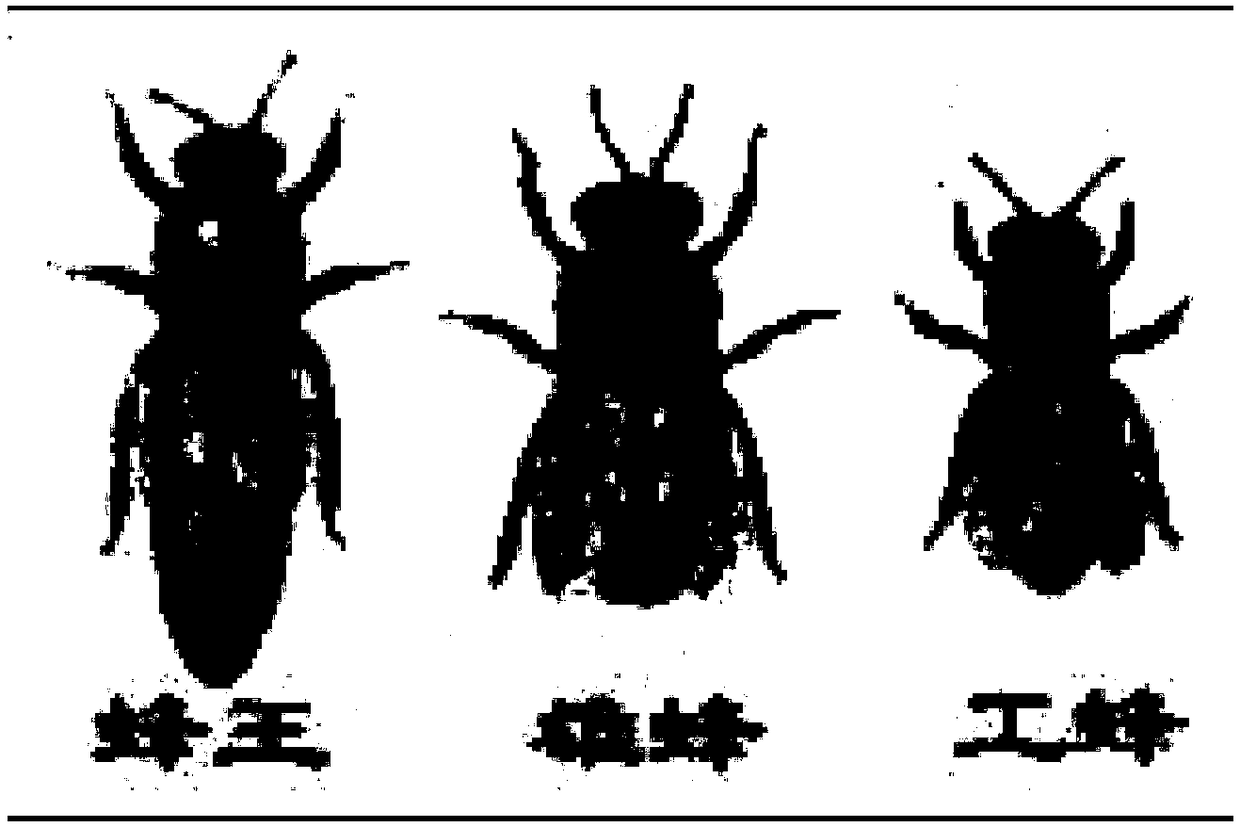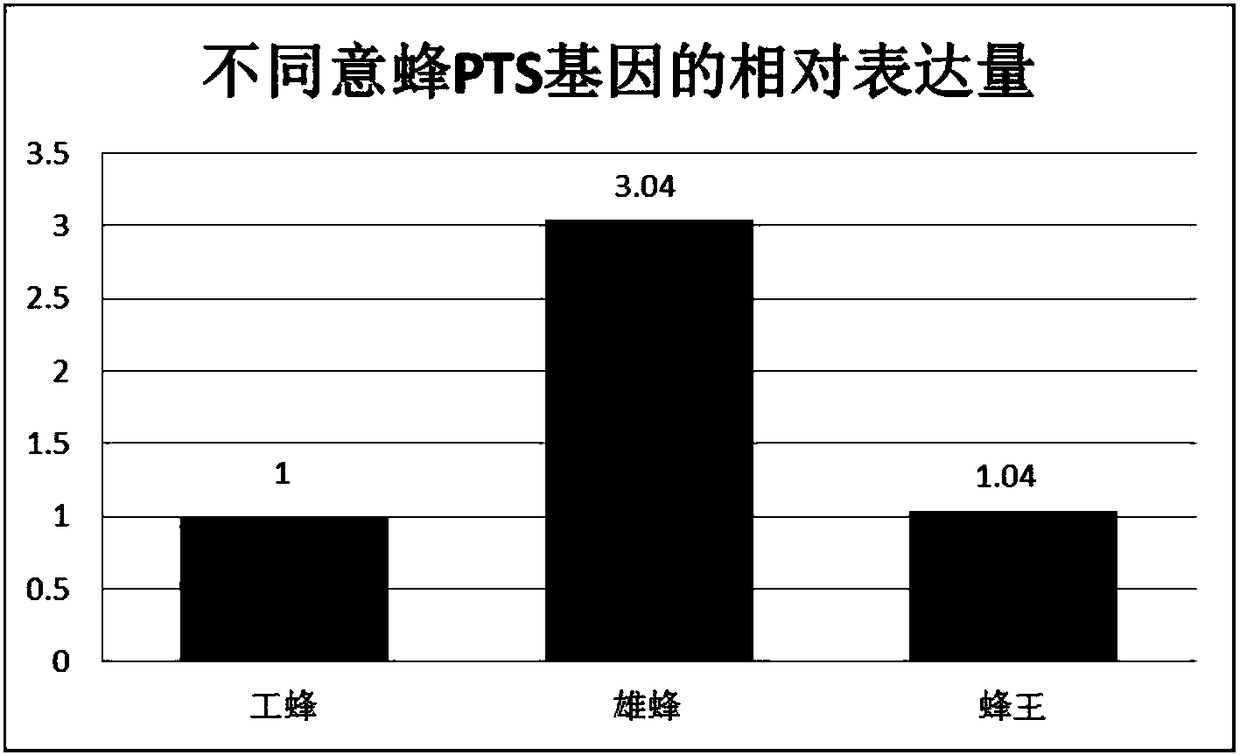Method for detecting 6-pyruvoyl tetrahydropterin synthase PTS gene expression of Italian bee through fluorescent quantitative PCR (Polymerase Chain Reaction) technology
A technology of acetone tetrahydropterin and Italian bees, applied in the biological field, can solve the problems of no research reports on Hymenoptera insects, and achieve the effects of shortening experiment time, improving sensitivity, ensuring reliability and repeatability
- Summary
- Abstract
- Description
- Claims
- Application Information
AI Technical Summary
Problems solved by technology
Method used
Image
Examples
Embodiment 1
[0036] Obtaining the PTS Gene Sequence of Italian Apis mellifera
[0037] Open the Beebase (http: / / hymenopteragenome.org / beebase / ) database, enter the keyword PTS in the search bar, and find a result of PTS. Click PTS to get its Beebase database gene number GB51600. Click to enter the gene description page, select the link of the NCBI (https: / / www.ncbi.nlm.nih.gov / ) database, enter NCBI, and get the gene number LOC412015, the mRNA number of Ref-seq is XM_006571326.2, Protein The number is XP_006571389.1, that is, the CDS sequence of PTS such as (SEQ ID NO.4) and the amino acid sequence such as (SEQ ID NO.5) are obtained.
Embodiment 2
[0039] Extraction of Total RNA from Apis mellifera
[0040] Three species (three parallel samples in each group) of healthy Italian bees (worker bees, drones and queen bees) were selected to conduct the experiment of measuring the relative expression of PTS in different bees. An appropriate amount of healthy Italian bees of different species were selected and stored in -20°C freezer.
[0041] (1) Take 5 Italian worker bees and place them in a sterile mortar, pour liquid nitrogen into them and quickly grind them thoroughly with a grinding rod. Set for 5min.
[0042] (2) Add 200 μL of chloroform into the centrifuge tube, shake vigorously for 5-10 minutes, and let stand for 5 minutes.
[0043] (3) Centrifuge at 12,000 rpm for 10 min at 4°C, transfer the upper colorless aqueous phase into a new sterile centrifuge tube, add 500 μL of isopropanol, mix by inverting gently, let stand for 10 min, and centrifuge at 12,000 rpm for 10 min.
[0044] (4) Carefully pour off the liquid in ...
Embodiment 3
[0048] cDNA synthesis
[0049] The total RNA sequence of Apis mellifera (SEQ ID NO.3) described in Example 2 was used as a template. Take a sterilized 0.2mL centrifuge tube and add the following reaction system (20μL system):
[0050] (1) Add the following reagents to the nuclease-free PCR tube in ice bath: 800ng of RNA is reversed.
[0051]
[0052] (2) Gently mix and centrifuge for 3-5s. After incubating the reaction mixture at 65°C for 5 minutes, ice-bath for 2 minutes, and then centrifuge for 3-5s.
[0053] (3) Place the test tube in an ice bath, and then add the following reagents:
[0054] 5×RT Buffer 4.0ul
[0055] Thermo Scientific RiboLock RNase Inhibitor (20U) 0.5ul
[0056] RevertAid Premium Reverse Transcriptase (200U) 1.0ul
[0057] (4) Gently mix and centrifuge for 3-5s
[0058] (5) Carry out the reverse transcription reaction on the PCR instrument according to the following conditions
[0059] ①Incubate at 25°C for 10 minutes
[0060] ②cDNA synthesis ...
PUM
 Login to View More
Login to View More Abstract
Description
Claims
Application Information
 Login to View More
Login to View More - R&D
- Intellectual Property
- Life Sciences
- Materials
- Tech Scout
- Unparalleled Data Quality
- Higher Quality Content
- 60% Fewer Hallucinations
Browse by: Latest US Patents, China's latest patents, Technical Efficacy Thesaurus, Application Domain, Technology Topic, Popular Technical Reports.
© 2025 PatSnap. All rights reserved.Legal|Privacy policy|Modern Slavery Act Transparency Statement|Sitemap|About US| Contact US: help@patsnap.com



